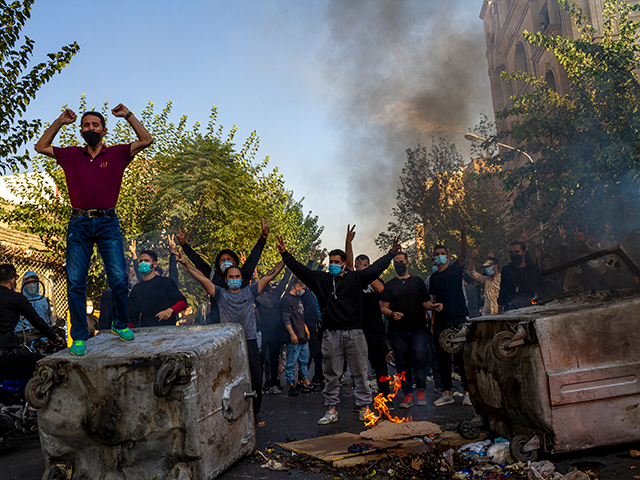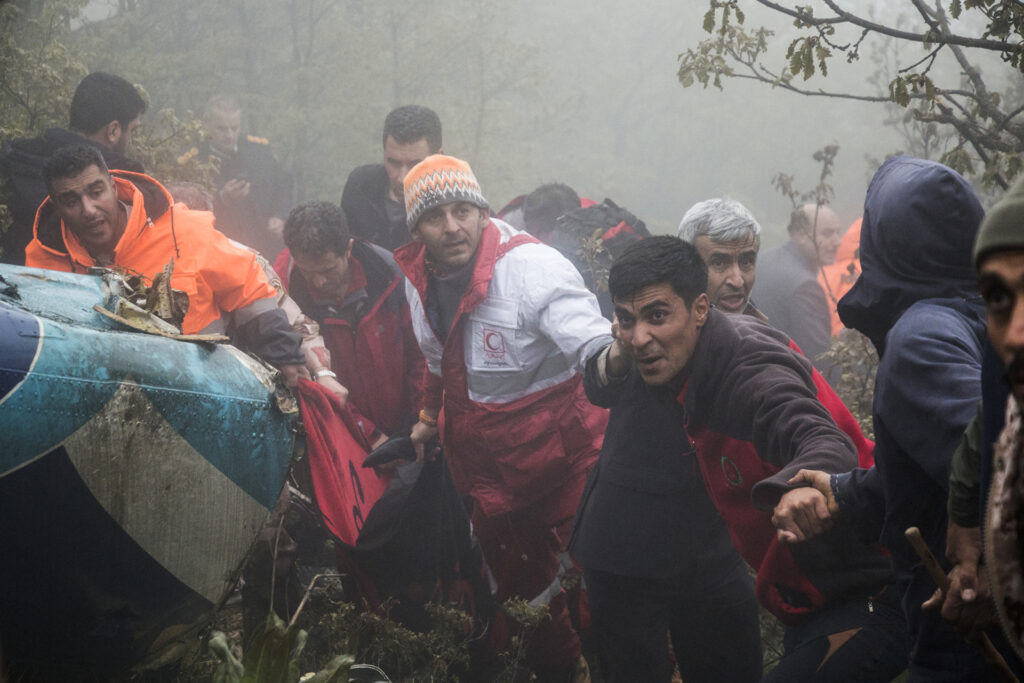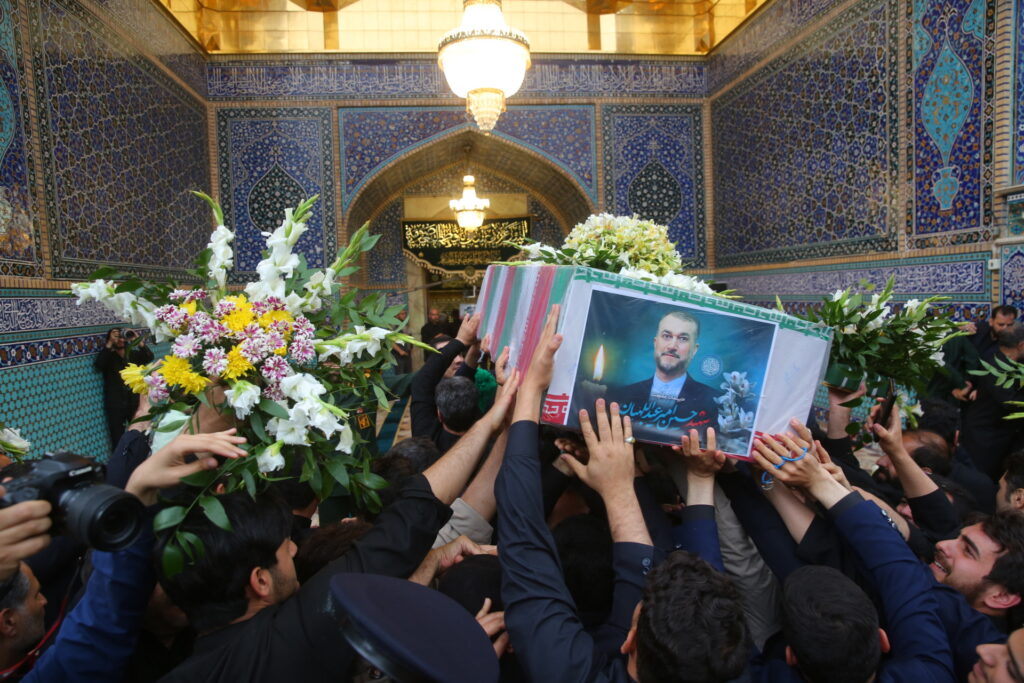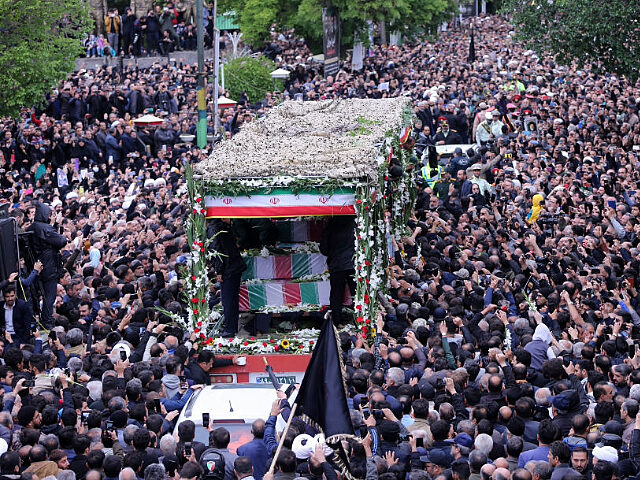The Islamist regime in Iran organized several large funeral processions on Tuesday for President Ebrahim Raisi, Foreign Minister Hossein Amir-Abdollahian, and the six others killed in a helicopter crash on Sunday.
Raisi served as president since 2021, overseeing one of the most violent periods of repression, particularly of women’s rights activists, in modern Iranian history. Before becoming president, he served as a top prosecutor, ensuring the executions of thousands of political dissidents. In 1988 alone, Raisi is believed to have played a major role in the execution of between 5,000 and 30,000 political prisoners.
The United Nations estimates that Raisi’s government killed more than 550 people in the aftermath of the 2022 protests that Iranian “morality police” triggered by beating to death Mahsa Amini, a 22-year-old woman accused of wearing her hijab incorrectly.

In this photo — taken by an individual not employed by the Associated Press and obtained by the AP outside Iran — Iranians protest the death of 22-year-old Mahsa Amini after she was detained by the morality police in Tehran on October 27, 2022. (AP Photo/Middle East Images, File)
Raisi, Amir-Abdollahian, and several other Iranian officials were traveling home on Sunday from Azerbaijan, where they attended an event celebrating the inauguration of a dam jointly built with the Azeri government. The helicopter reportedly crashed in foggy weather, and search and rescue efforts did not confirm its location or the deaths of its passengers until Monday.
Iranian state media initially reported the helicopter crash as a “hard landing” that had “not been rough,” claiming at least two passengers contacted Iranian officials still alive after the incident. Iranian officials said inclement weather hurt search operations, and all passengers were dead by the time they were found.

Rescuers recover bodies at the crash site of a helicopter transporting Iranian President Ebrahim Raisi, Foreign Minister Hossein Amir-Abdollahian, and others in a fog-covered mountainous area of Varzaghan in northwestern Iran on May 20, 2024. (AZIN HAGHIGHI/MOJ News Agency/AFP via Getty Images)
“Supreme leader” Ayatollah Ali Khamenei, Raisi’s boss, declared five days of mourning on Monday. Formal funerals began the next day in Tabriz, a northwestern Iranian city in East Azerbaijan province, where the helicopter crashed.
The Iranian state outlet PressTV claimed that “millions” participated in the Tabriz funeral procession, supporting Raisi with slogans of “allegiance” to Khamenei and the “principles of the Islamic Revolution.” PressTV claimed the mourners “vowed to stand firm against enemies” despite the Iranian government not, at press time, blaming any “enemies” for any involvement in Raisi’s death.
Iranian state media published images of large crowds dressed in black flooding Tabriz. Iran is a repressive Islamist state that brutally punishes any public displays of dissidence with the regime. As such, absence from such an event can be interpreted as a potential disagreement with Khamenei’s ongoing rule and could jeopardize the safety of an Iranian citizen.
Interior Minister Ahmad Vahidi reportedly spoke at the first funeral, attempting to offer Revolutionary loyalists hope.
“We had a bad landing in this matter, but we will have a brilliant rise,” Vahidi reportedly said.
Iranian officials have planned another funeral event in the city of Qom on Tuesday and a larger formal gathering in Tehran on Wednesday. The latter event will feature prayers by Khamenei himself.
The elaborate displays of affection and insistence that Raisi was a “popular” figure among the Iranian people follow reports of celebrations in Iran following the news of his death. The American outlet Voice of America (VOA) relayed that videos circulating on social media showing Iranians sharing sweets as a way of celebrating Raisi’s death were “credible.” Iran International, a dissident news outlet, published videos of fireworks over Tehran following the news of the helicopter crash.
“Videos posted to social media and shared with VOA Persian showed Iranians dancing to music in London, Copenhagen, The Hague, and Hamburg,” the outlet reported.
Those saddened by his death who spoke to Reuters lamented only that, as Raisi was not the head of the Iranian government, his death would likely not result in the demise of the entire Islamist regime.

People carry coffins during a funeral procession in Qom on May 21, 2024, for Iranian President Ebrahim Raisi, Foreign Minister Hossein Amir-Abdollahian, and six other passengers and crew who were killed in a helicopter crash on a fog-shrouded mountainside in the northwest. (Ahmad Zohrabi/picture alliance via Getty Images)
Iranian celebrations aside, many world leaders offered condolences to Tehran for Raisi and Amir-Abdollahian’s death, including close allies — such as the Chinese Communist Party and the government of leftist American President Joe Biden — despite Iran regularly calling for the “death” of the nation.
U.S. State Department spokesman Matthew Miller issued a statement on Monday offering America’s “official condolences” to Iran for the deaths. The chaplain of the U.S. Senate, Barry Black, offered a prayer on the Senate floor for the souls of the departed, which circulated widely on regime-friendly Iranian media.
The Iranian regime has scheduled nearly a week’s worth of events to honor Raisi and appointed his first vice president, Mohammed Mokhber, to serve as interim president. Mokhber will serve through June 28, when Tehran will hold a special version of its usual rigged presidential “elections.” In Iran, Khamenei gets the final say over all candidates on the presidential ballots, ensuring his hand-picked candidate always wins.
Raisi “won” the 2021 presidential “elections” with record-low turnout, as Iranians boycotted the event to protest their lack of choice in political leaders. The “Guardian Council,” which formally accepts or rejects candidates for elections, banned 592 people from appearing on the ballot, including former President Mahmoud Ahmadinejad.

COMMENTS
Please let us know if you're having issues with commenting.